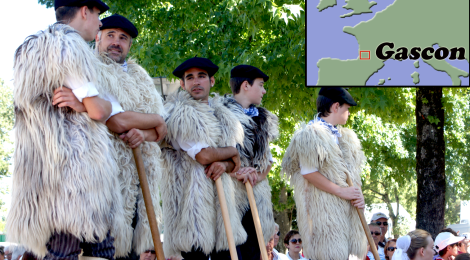
Gascon people
The Gascon are an Atlantic-Pyreneean people that live in Southwest Europe. Their land has its northern and eastern border by the Garonne river from its source in the Aran Valley to its estuary near Bordeaux. They speak a Romance language closely linked with other Occitano-Romance varieties like Occitan and Catalan. Gascon language also shares a sizeable piece of lexicon, morphology and phonetics with Aragonese.
Historically, the Aquitanians, a people that spoke a pre-Indo-European language, inhabited most of the lands that are now called Gascony. The Aquitanians were in all likelihood related to the Vascones that lived on the southern side of the Pyrenees. The area was settled by the Romans in Burdigala (now Bordeaux) and Lapurdum (now Bayonne), as well as several other ‘castra’. After the Fall of the Roman Empire, Germanic tribes rampaged through Southwestern Europe and the Aquitanian area was apparently taken over by the Vascones that came down from the Pyrenees to the plains of Gascony. The name of Gascony itself comes from the Germanic word for the land of the Vascones: Wasconia.
The peoples living in Wasconia had an Aquitanian substrate and a Vasconian superstrate that was mingled together with the Celtic-Roman population and the few Germanic newcomers. From this melting pot a distinct Gascon language arose around the 10th century AD. Their neighbour Occitans distinguished both Gascon and Occitan as separate languages since early times, and the peculiar sound changes particular to Gascon (and its own morphology too) provoked that Occitan speakers called it ‘langatge estranh’ (strange or foreign language).
Most of Aquitaine fell under English rule during the 100 Years War, while Bearn was tightly linked to the kingdom of Navarre for many centuries, eventually with a Gascon-Bearnese dinasty ruling Navarre and finally France too. While Basque language was still spoken in Middle Ages in some parts of Gascony, it stood the longest in Bearn, where a village of the Oloron commune is still Basque, in close relationship with the Basque province of Soule, which has been part of Bearn for many centuries.
The fact is that for the most part Gascons have been regarded as Latinised Basques, and the border between the two peoples is somehow blurred. Gascons populated towns in Navarre (where old documents are frequently found written in Gascon) and Gipuzkoa (especially on the coast: San Sebastian, Pasaia, Hondarribia), where Gascon was spoken until early 20th century. Some towns in north Labourd province of the Basque Country such as Bidaxune, Bardoze and Bastida have been traditionally inhabited by mixed families of both Gascon and Basque heritage, locally called ‘Xarnegos’. Bayonne is now considered the Basque capital in the North, but Gascon was the most commonly used language there until the imposition of French.
Notable historical characters from Gascony are Richard Lionheart who, although born in England, wrote poetry in Gascon, and D’Artagnan, the musketeer, whose fictionalised life was written by Alexandre Dumas.
Together with poetry, Gascons are noted for their traditional music and colourful festivals. Among the music instruments of Gascony are the boha (cornemuse landaise), the flabuta (three-holed flute), the tambourin (a stringed drum) and the bot (Aranese bagpipe).
Gascon language is endangered in France, and until very recently it was widely despised as poor French or dialectal ‘patois’, only belonging to illiterate or countryside people. It is now official in the Aran Valley (‘aran’ means valley in Basque), which is a variety, albeit within Pyreneean Gascon and its own peculiarities, influenced by Occitan and Catalan. In Bayonne, there is trilingual signalisation on the streets in French, Basque and Gascon.

Recent Comments